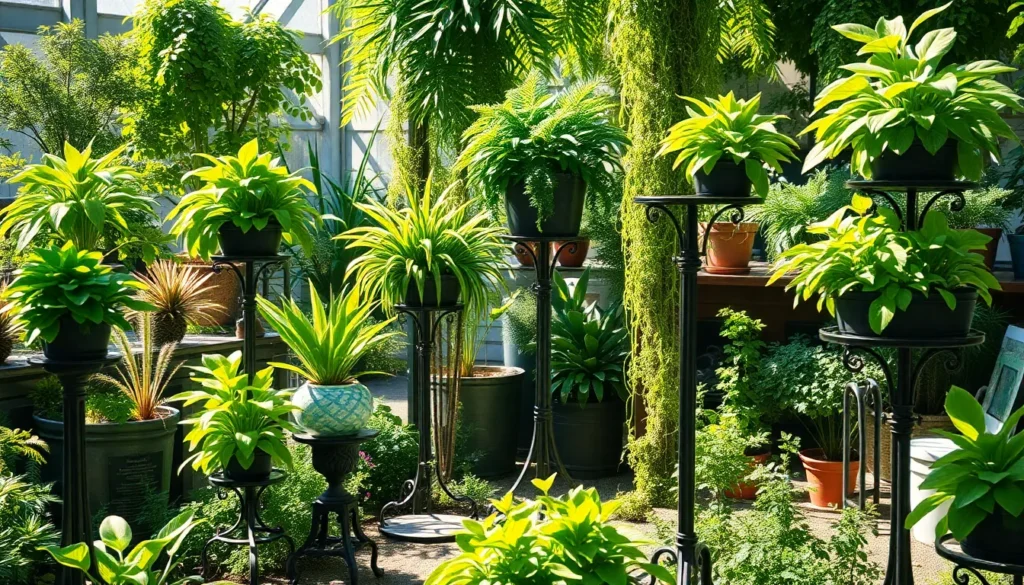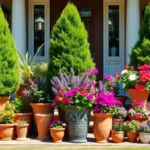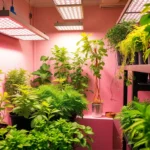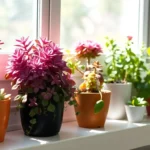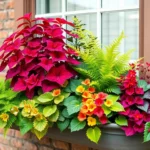We’ve all been there – watching our beloved plants struggle to thrive even though our best efforts. While we focus on watering schedules and sunlight requirements, there’s often an overlooked element that could be the key to transforming our gardens: iron stands for plants.
These essential nutrients play a crucial role in plant health, affecting everything from leaf color to overall growth vigor. When plants lack sufficient iron, they develop chlorosis – that telltale yellowing of leaves that signals distress. We’ll explore how iron deficiency impacts your plants and why incorporating iron supplements into your gardening routine can make all the difference.
Whether you’re dealing with struggling houseplants or an entire garden that’s lost its luster, understanding iron’s role in plant nutrition empowers us to create thriving green spaces. Let’s jump into the science behind iron supplementation and discover practical answers that’ll have your plants flourishing in no time.
Choose the Right Size Iron Stand for Your Plant Collection
Selecting the proper iron stand size ensures your plants receive adequate support while maintaining aesthetic appeal in your space. We’ll guide you through the essential measurements and considerations for finding the perfect fit.
Measure Your Plant Pot Dimensions
Start by measuring your pot’s diameter at its widest point. Most iron plant stands accommodate pots ranging from 6 inches to 16 inches in diameter. Record the exact measurements of your current pots and any future containers you plan to use.
Check the pot’s base diameter as well. Some decorative pots have wider tops than bottoms, which affects stability on the stand. We recommend choosing stands with rings or platforms that match your pot’s base measurements rather than the rim.
Note the pot’s height to ensure proper clearance. Taller pots need stands with adequate vertical space between tiers if you’re using multi-level designs. Standard pot heights range from 4 inches for small succulents to 12 inches for larger houseplants.
Consider Weight Capacity Requirements
Evaluate the total weight including soil and water. A typical 10-inch ceramic pot with moist soil weighs between 8 to 15 pounds. Iron stands typically support weights from 20 pounds for basic models up to 50 pounds for heavy-duty versions.
Factor in seasonal watering changes that affect weight. During growing seasons, we water more frequently, increasing the overall load on your iron stand. Choose stands rated for at least 25% more than your calculated weight to ensure safety margins.
Account for decorative elements and saucers. Plant saucers, decorative stones, and moss add 2 to 5 pounds to your setup. Premium iron stands with reinforced joints handle these additional weights without compromising structural integrity.
Account for Plant Growth Over Time
Plan for your plant’s mature size when selecting stand height. Fast-growing plants like pothos or monstera can double in size within 12 months. We suggest choosing adjustable iron stands or models with removable tiers for flexibility.
Consider repotting schedules in your sizing decisions. Most houseplants need larger containers every 2 to 3 years as their root systems expand. Select stands that accommodate the next pot size up from your current containers.
Think about adding companion plants to your display. Multi-tier iron stands allow you to expand your collection vertically. Choose models with varying platform sizes to create ever-changing arrangements as your plant family grows.
Select Durable Materials That Complement Your Decor

Choosing the right iron material determines both the longevity and aesthetic appeal of your plant stands. Material selection impacts not only durability but also how well the stand integrates with your existing home design.
Wrought Iron for Traditional Elegance
Wrought iron plant stands bring timeless sophistication to any traditional or vintage inspired space. This material contains low carbon content and features a fibrous internal structure that makes it highly malleable and perfect for intricate decorative designs. We particularly appreciate how wrought iron bends rather than breaks under pressure, contributing to its exceptional durability and resistance to fatigue.
Craftsmen shape wrought iron by heating and working it with tools, allowing for elegant curves and detailed patterns that complement classic decor styles. The malleable nature of this material enables designers to create ornate scrollwork and decorative elements that make each stand a focal point. Traditional homes and formal gardens benefit most from wrought iron’s sophisticated appearance and proven longevity.
Powder-Coated Steel for Modern Durability
Powder coated steel offers contemporary aesthetics while delivering superior practical benefits for modern plant displays. This material features a durable powder finish that resists rust, corrosion, and everyday wear, making it ideal for busy households. Maintenance requirements remain minimal compared to other iron types, and the economical pricing makes it accessible for various budgets.
Modern decor styles particularly benefit from powder coated steel’s clean lines and versatile appearance. The coating process creates a smooth, uniform finish that complements contemporary furniture and minimalist design principles. We recommend this material for homeowners who want reliable performance without sacrificing style versatility.
Cast Iron for Maximum Stability
Cast iron provides unmatched stability through its dense, heavy construction that keeps plant stands firmly positioned. Manufacturers create this material by melting iron and pouring it into molds, resulting in a harder metal with higher carbon content. The brittleness that comes with higher carbon content makes cast iron less malleable but excellent at maintaining its shape under heavy loads.
Weight distribution becomes exceptionally stable with cast iron stands, making them perfect for larger plants or multiple pot arrangements. Traditional and rustic decor styles showcase cast iron’s solid, substantial appearance most effectively. But, we note that cast iron can crack under high impact due to its brittle nature, so careful placement and handling remain important considerations.
| Material | Carbon Content | Durability Feature | Best Decor Match |
|---|---|---|---|
| Wrought Iron | Low | Bends rather than breaks | Traditional elegance |
| Powder-Coated Steel | Medium | Rust and corrosion resistant | Modern and versatile |
| Cast Iron | High | Maximum stability and weight | Traditional, rustic |
Position Your Iron Plant Stands for Optimal Plant Health
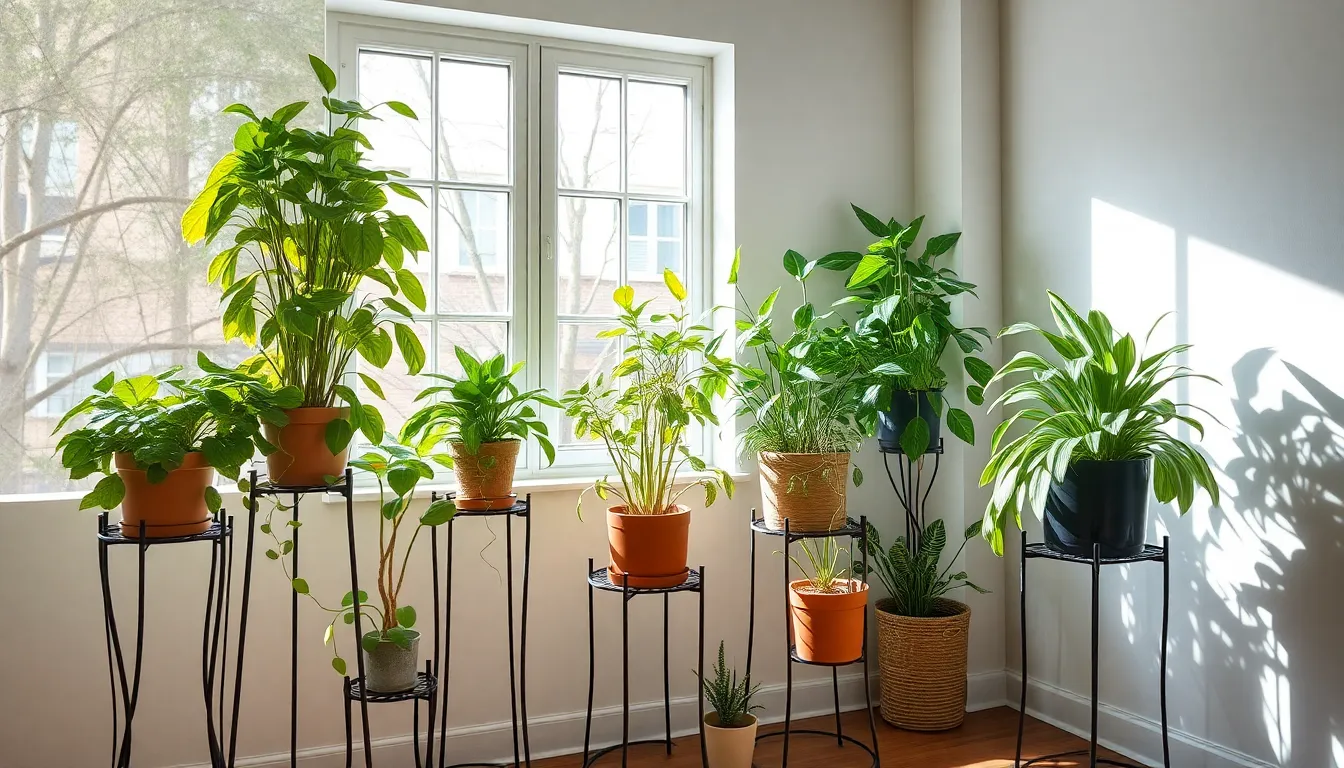
Strategic placement of your iron plant stands directly impacts how well your plants thrive. We’ll explore the key positioning factors that maximize both plant health and the durability benefits of iron stands.
Ensure Adequate Light Exposure
Light requirements vary dramatically between plant species, so we position our iron stands based on each plant’s exact needs. Direct sunlight lovers like succulents thrive when we place their stands near south-facing windows, while shade plants prefer spots with filtered light. Iron’s moisture-resistant properties make these stands ideal for humid environments where light conditions fluctuate throughout the day.
Photosynthesis depends entirely on proper light exposure, and elevated positioning helps us achieve optimal angles. We can easily move iron stands to follow seasonal light patterns since they’re built to withstand frequent repositioning. Their durability means we don’t worry about weakening joints or surfaces when adjusting placement for changing light conditions.
Height adjustment becomes crucial for maximizing light penetration to lower leaves. We use iron stands to lift plants closer to light sources or create layered displays where each plant receives appropriate exposure. This elevation strategy works particularly well in rooms with limited natural light.
Maintain Proper Air Circulation
Airflow around plant foliage reduces fungal diseases and prevents the stagnant conditions that lead to root rot. We elevate plants on iron stands to promote natural air movement, which helps moisture evaporate from soil surfaces and leaf surfaces. This circulation becomes especially important in humid indoor environments where iron’s moisture resistance provides long-term reliability.
Pest prevention improves significantly when we raise plants off ground level using sturdy iron stands. Slugs, snails, and other crawling pests find it harder to reach elevated plants, giving us a natural defense mechanism. We’ve found this elevation strategy particularly effective for outdoor plant displays where ground-dwelling pests are common.
Spacing between plants increases when we use iron stands of varying heights, allowing air to flow freely around each specimen. We arrange stands to create wind corridors that naturally ventilate our plant collections. This strategic spacing prevents overcrowding while maintaining visual appeal.
Consider Drainage and Floor Protection
Water damage to flooring becomes preventable when we use iron stands that elevate pots above surface level. We position saucers or drip trays beneath elevated planters to catch excess water while maintaining proper drainage. Iron’s resistance to moisture means these stands won’t deteriorate even in areas with frequent watering.
Root health improves dramatically when excess water drains freely from elevated pots rather than pooling at the bottom. We ensure our iron stands allow water to escape through drainage holes, preventing the waterlogged conditions that cause root rot. This elevation creates optimal growing conditions for most houseplants and outdoor specimens.
Soil spillage containment becomes manageable with properly positioned iron stands that keep mess contained to designated areas. We place protective mats or trays under stands in areas where soil might scatter during repotting or maintenance. The durability of iron stands means they can handle the weight of large pots filled with moist soil without bending or warping.
Style Your Space With Different Iron Stand Designs
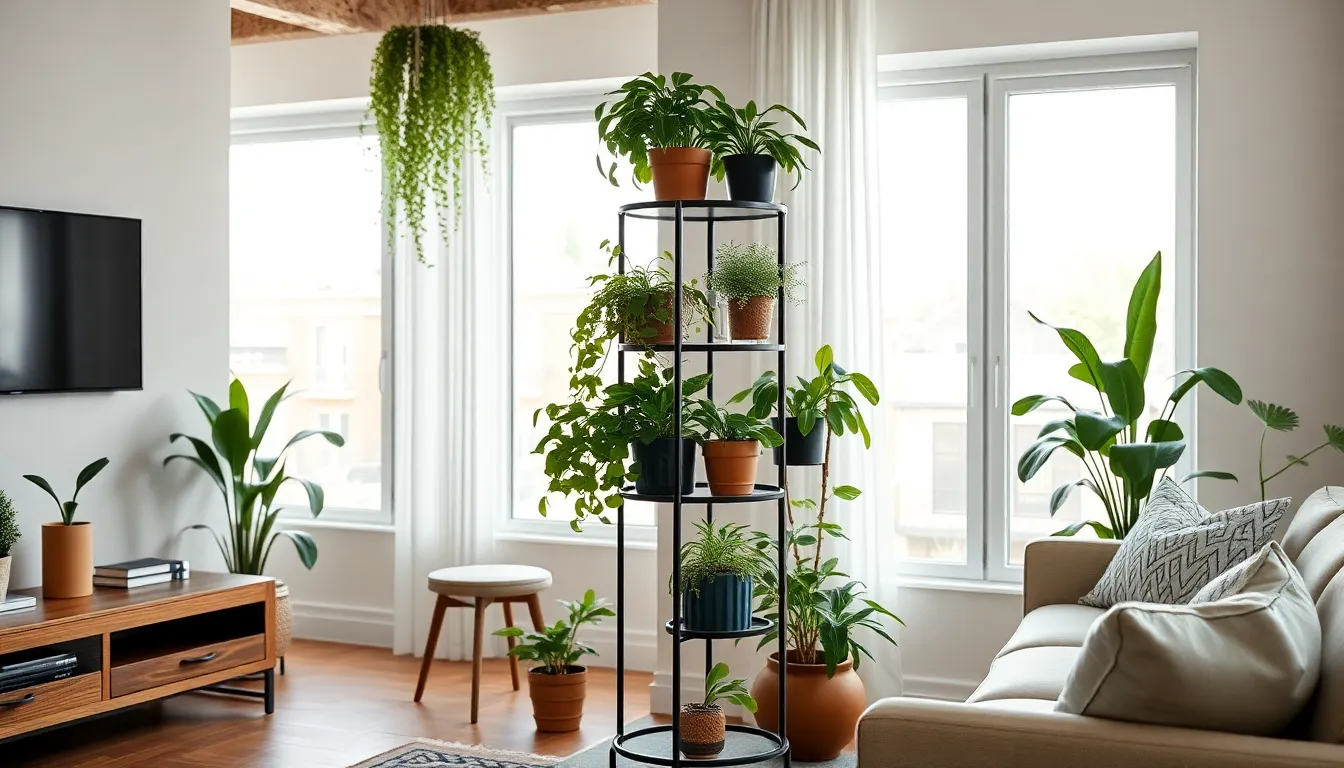
Iron plant stands transform your living spaces through their distinctive industrial charm and remarkable versatility. These durable pieces complement various interior styles while providing functional answers for plant display challenges.
Tiered Stands for Multiple Plants
Tiered iron stands maximize your plant collection’s visual impact through strategic vertical arrangement. These multi-level designs typically feature 2-tier or 3-tier configurations that create stunning layered garden effects while conserving valuable floor space. We’ve found them particularly effective in small apartments, patios, and balconies where every square inch counts.
Each tier accommodates different plant sizes safely thanks to iron’s robust construction capabilities. The varying heights allow trailing plants to cascade naturally while upright specimens reach toward available light sources. These stands work exceptionally well for herb gardens, succulent collections, or mixed arrangements that need organized display answers.
Single Pedestal Stands for Statement Plants
Single pedestal iron stands elevate individual plants into commanding focal points throughout your home. Their minimalist design philosophy emphasizes the plant’s natural beauty while providing sturdy support for larger specimens. We recommend positioning these stands in entryways, living rooms, or office spaces where they can serve as conversation starters.
The elevated placement draws attention to your plant’s unique foliage patterns and growth habits. These stands suit fiddle leaf figs, monstera deliciosas, or other architectural plants that deserve prominent positioning. Their simple yet strong construction ensures your statement pieces remain stable while commanding attention from every angle.
Corner Stands for Space Optimization
Corner iron plant stands transform neglected spaces into vibrant green sanctuaries through clever triangular or L-shaped designs. These specialized stands fit snugly into corners without interfering with your room’s traffic flow patterns. Multiple tiers within corner configurations provide maximum plant capacity while maintaining spatial efficiency.
We appreciate how these stands brighten previously unused areas while keeping pathways clear for daily activities. Their iron construction offers weather resistance for covered outdoor corners or sunroom applications. The compact footprint makes them ideal for studio apartments or rooms where traditional plant placement options feel overwhelming.
Maintain Your Iron Stands for Plants With Proper Care
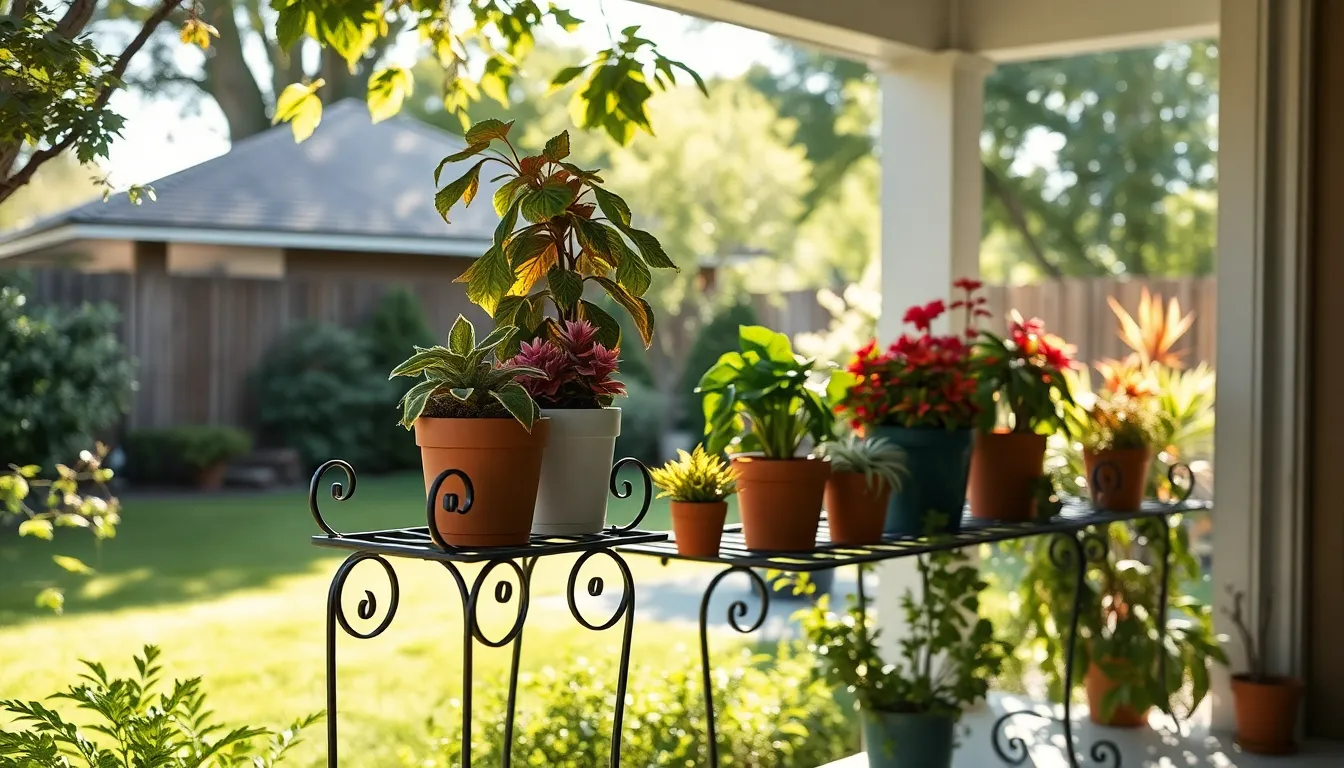
Proper maintenance ensures your iron plant stands remain beautiful and functional for years to come. We’ll guide you through essential care practices that protect your investment and keep your plant displays looking their best.
Regular Cleaning and Rust Prevention
Dust your iron stands weekly using a soft cloth or brush to remove dirt and debris that can trap moisture and accelerate rust formation. Accumulated particles create the perfect environment for corrosion to develop.
Clean thoroughly with mild dish soap and warm water when you notice buildup or staining. We recommend avoiding harsh chemicals or abrasive cleaners that can damage the protective iron surface coating.
Dry completely after each cleaning using a soft towel to prevent water spots and rust development. Moisture left on iron surfaces creates the ideal conditions for oxidation to begin.
Remove surface rust immediately by gently sanding affected areas with fine sandpaper or using a wire brush attachment on your drill for hard to reach spots. Early intervention prevents rust from spreading to larger areas.
Apply protective coatings regularly such as WD-40 or boiled linseed oil after cleaning to restore shine and create a barrier against future corrosion. These treatments help maintain the iron’s original appearance while extending its lifespan.
Reapply specialized sealants periodically like mineral oil or cast iron exact products to maintain surface protection. Consistent application of these protective layers significantly reduces maintenance needs over time.
Seasonal Weather Protection
Position stands strategically in locations where exposure to excessive moisture and direct sunlight stays minimized throughout different seasons. Smart placement reduces weather related damage before it occurs.
Move stands to sheltered areas during heavy rain or snow seasons to reduce rust risk and prevent weather related deterioration. Covered porches or indoor spaces provide excellent temporary protection.
Use protective covers when moving stands isn’t practical to shield them from harsh weather conditions. Quality covers designed for outdoor furniture work well for this purpose.
Monitor weather forecasts and plan protective measures in advance of severe conditions. Proactive care prevents damage that requires extensive restoration later.
Proper Storage During Off-Season
Store stands in dry, covered locations when not actively displaying plants to prevent moisture accumulation and rust development during inactive periods. Basements, garages, and sheds provide ideal storage environments.
Clean and apply protective coatings before storage to ensure stands remain in excellent condition throughout the off season. This preparation step saves important restoration time when you’re ready to use them again.
Remove all plant residue and soil particles that might trap moisture or cause corrosion at contact points during storage. Thorough cleaning prevents problems from developing while stands aren’t being monitored.
Check stored stands monthly to ensure storage conditions remain dry and protective coatings stay intact. Regular inspections allow you to address any developing issues quickly.
Budget Wisely for Quality Iron Plant Stands
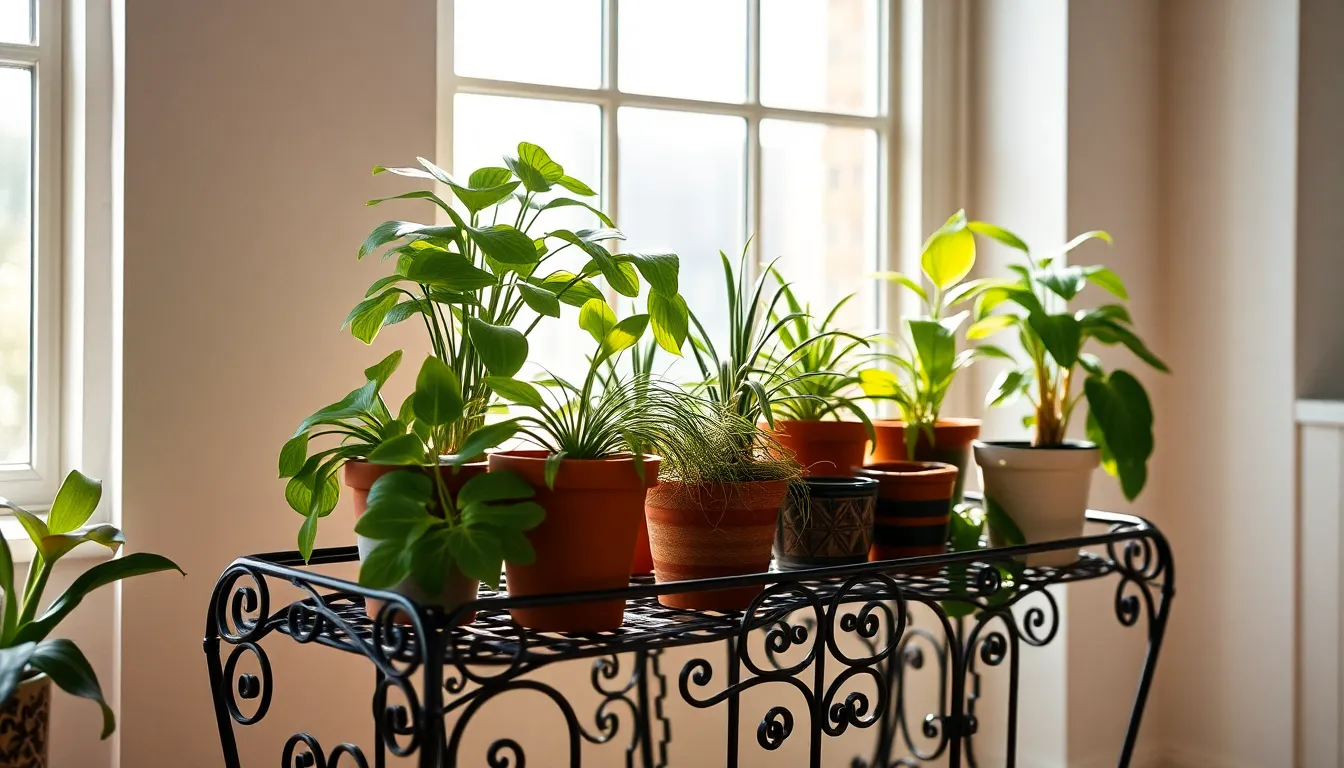
Smart budgeting for iron plant stands ensures we get the durability and style our plants deserve without overspending. Setting a reasonable budget helps us secure quality iron construction that resists bending and maintains structural integrity over time.
Compare Price Points and Features
Iron stands vary significantly in price based on design complexity, size, and manufacturing quality. We should compare stands by weight capacity since heavier designs typically indicate thicker metal construction and better stability. Decorative wrought iron stands with ornate patterns cost more than simple minimalist designs, but they add artistic value to our plant displays.
Features like tiered shelves for multiple plants, caster feet for easy mobility, and decorative accents affect pricing structures. Powder coated finishes command higher prices than basic paint but offer superior rust resistance for long term use. Stainless steel alternatives provide better corrosion protection but typically require higher initial investments compared to traditional iron options.
Weight capacity ratings help us determine if stands can support our heaviest potted plants safely. Design complexity ranges from simple geometric shapes to elaborate Victorian inspired patterns that serve as decorative focal points. Finish quality determines how well stands resist moisture damage and maintain their appearance over time.
Invest in Long Term Durability
Quality iron stands require protective finishes to prevent rust formation when exposed to moisture and humidity. Powder coating provides the most durable surface protection, creating a barrier that extends the stand’s lifespan significantly. Painted finishes offer basic protection but may require touch ups or refinishing after several years of use.
Stainless steel stands offer superior rust resistance and require minimal maintenance throughout their lifespan. We should consider the higher upfront cost of stainless steel as an investment in longevity and reduced replacement expenses. Quality construction includes welded joints rather than screwed connections, which provide stronger structural integrity under plant weight.
Thickness of metal components affects durability, with heavier gauge materials resisting bending and warping better than thin alternatives. Weather resistant coatings become essential for stands used in humid environments or near windows with condensation. Investment in quality materials saves money over time by eliminating frequent replacements and repairs.
Factor in Assembly and Shipping Costs
Assembly requirements vary from pre assembled stands to complex multi piece designs requiring tools and installation time. We should account for shipping costs since iron stands weigh significantly more than plastic or wooden alternatives. Heavy stands often incur higher shipping fees that can add 20 to 30 percent to the total purchase price.
Local purchasing eliminates shipping expenses while allowing us to inspect build quality before buying. Some retailers offer free shipping promotions that make online purchases more economical for heavy iron stands. Assembly complexity affects our time investment, with intricate designs potentially requiring professional help or specialized tools.
Pre assembled options cost more initially but save labor time and eliminate assembly errors that could affect stability. We should factor delivery timeframes since heavy items may require freight shipping with longer wait times. Return policies become important considerations given the difficulty and expense of shipping heavy iron stands back to retailers.
Avoid Common Mistakes When Using Iron Plant Stands
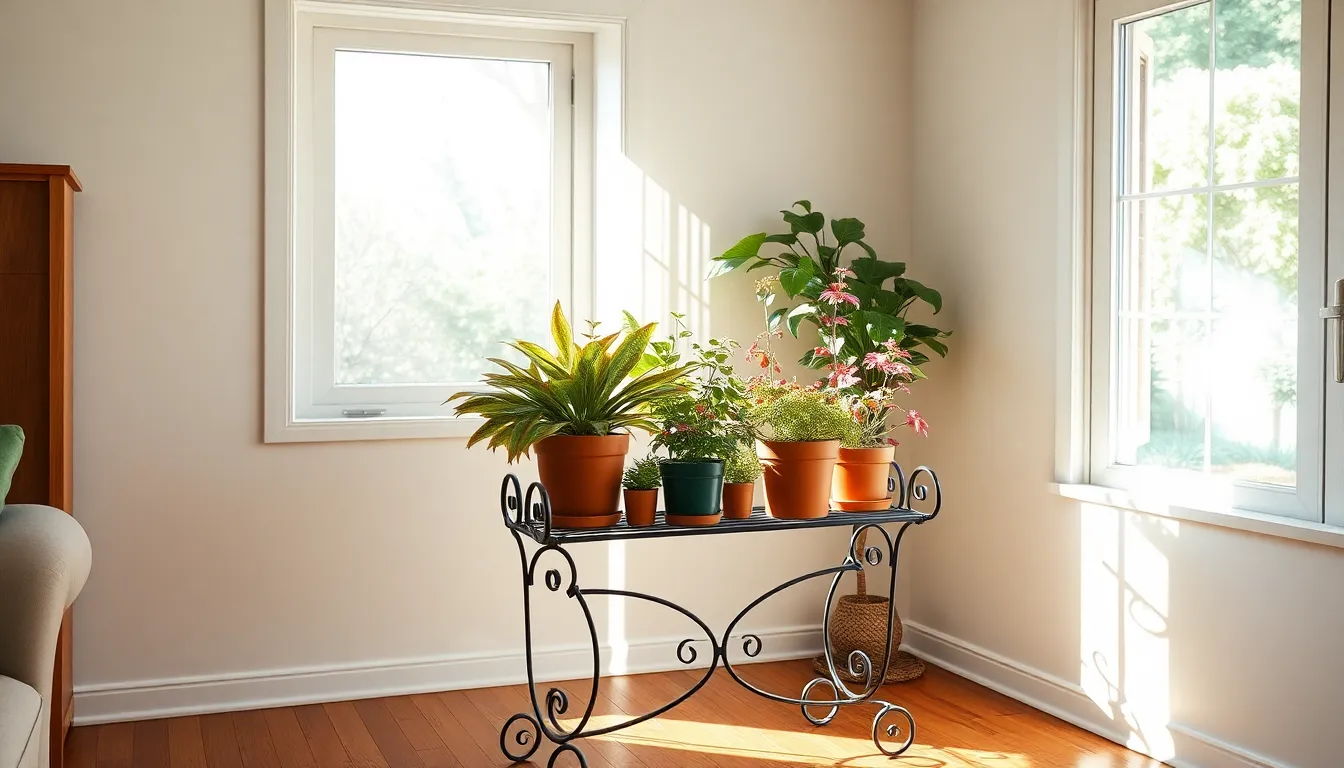
Making informed decisions about iron plant stand usage helps prevent costly damage and ensures our plants thrive safely. We’ll explore the most critical errors that can compromise both plant health and home safety.
Overloading Weight Limits
Exceeding manufacturer weight specifications ranks as the most dangerous mistake we can make with iron plant stands. Most stands display weight capacities clearly on packaging or product descriptions, yet many gardeners ignore these crucial limits. Overloading causes structural failure, bending, or complete collapse that damages plants, flooring, and potentially injures people nearby.
We should always verify the total weight before placing items on our stands. This includes the pot weight, soil moisture content, and any decorative elements like stones or plant saucers. Heavy ceramic pots filled with wet soil can easily exceed a 20-pound weight limit that seems generous for smaller arrangements.
Checking weight limits becomes especially important when we repot plants into larger containers or add multiple plants to tiered stands. The cumulative weight often surprises gardeners who focus only on individual pot sizes rather than total load capacity.
Placing Stands in High-Traffic Areas
Positioning iron plant stands in busy walkways creates unnecessary safety hazards throughout our homes. High foot traffic areas like hallways, entryways, and kitchen passages increase the likelihood of accidental bumps and falls. Even sturdy iron stands tip over when subjected to unexpected contact from people, pets, or moving furniture.
We must consider daily movement patterns when selecting stand locations. Areas near doorways, between furniture pieces, or along narrow passages pose particular risks for accidents. Children and pets especially benefit from strategic placement away from their regular play zones and pathways.
Corner placements and wall adjacent positions offer much safer alternatives that still provide excellent plant display opportunities. These locations reduce collision risks while maintaining the decorative impact we desire from our plant arrangements.
Ignoring Stability on Uneven Surfaces
Uneven flooring undermines even the sturdiest iron plant stands and creates wobbling that leads to falls. We often overlook slight floor variations that become problematic when supporting elevated plant displays. Outdoor patios, wooden floors, and carpeted areas frequently present stability challenges that require attention.
Level surfaces are essential for maintaining proper balance, especially with taller stands or top heavy plant arrangements. We can use rubber feet, adjustable leg extenders, or small shims to compensate for minor surface irregularities. These simple additions significantly improve grip and prevent the rocking motion that eventually causes stands to tip.
Regular stability checks help us identify developing problems before they cause damage. Testing stands periodically by gently pressing different sides reveals loosening connections or shifting that needs immediate correction. Wider base designs and multiple leg configurations offer inherently better stability on challenging surfaces than narrow or single post stands.
Conclusion
Iron stands offer the perfect blend of functionality and style for plant enthusiasts. We’ve explored how proper sizing ensures stability while durable materials like wrought iron and powder-coated steel provide lasting beauty. Strategic placement maximizes plant health through improved light exposure and air circulation.
Regular maintenance keeps these stands looking their best while preventing costly replacements. By avoiding common mistakes and investing in quality construction we can create stunning plant displays that enhance our living spaces for years to come.
Whether you’re showcasing a single statement plant or creating a tiered garden display iron stands deliver the reliability and elegance modern homes demand.
Frequently Asked Questions
What is iron deficiency in plants and how can I identify it?
Iron deficiency in plants is characterized by chlorosis, where leaves turn yellow while veins remain green. This occurs because iron is essential for chlorophyll production and overall plant growth. Plants suffering from iron deficiency appear distressed and may show stunted growth. The yellowing typically starts with younger leaves first, distinguishing it from other nutrient deficiencies.
How do I choose the right size iron plant stand for my plants?
Measure your pot’s diameter and height, then select a stand that provides adequate support with some room for growth. Consider the total weight including soil, water, and decorative elements. Account for future plant growth and potential repotting needs. Adjustable stands offer flexibility as your plants mature and require larger containers over time.
What are the best materials for iron plant stands?
Three main iron materials excel for plant stands: wrought iron offers traditional elegance and exceptional durability; powder-coated steel provides modern aesthetics with rust resistance; and cast iron delivers maximum stability for heavy plants. Choose based on your decor style, weight requirements, and maintenance preferences for optimal performance and appearance.
Where should I place iron plant stands for optimal plant health?
Position stands to ensure adequate light exposure based on each plant’s specific needs. Maintain proper air circulation to prevent fungal diseases and promote healthy growth. Ensure good drainage to protect flooring and prevent root rot. Elevating plants on iron stands improves light penetration, airflow, and makes pest monitoring easier.
What iron stand designs work best for different spaces?
Tiered stands maximize visual impact while conserving floor space, perfect for plant collections. Single pedestal stands showcase statement plants beautifully. Corner stands optimize neglected areas efficiently. Choose designs based on your available space, plant sizes, and aesthetic preferences to create functional and attractive plant displays.
How do I maintain iron plant stands to prevent rust?
Clean stands regularly with dusting and mild soap to remove dirt and moisture. Apply protective coatings and sealants annually to extend lifespan. Provide seasonal weather protection through strategic placement and protective covers during harsh conditions. Store stands properly during off-seasons in dry locations to prevent moisture accumulation and rust development.
How much should I budget for quality iron plant stands?
Set a reasonable budget considering design complexity, size, and features. Heavier designs typically indicate better stability and durability. Invest in protective finishes and quality construction for long-term value. Factor in assembly requirements and shipping costs when comparing prices. Quality stands are worth the investment for safety and longevity.
What common mistakes should I avoid with iron plant stands?
Never exceed weight limits as this can cause structural failure and damage. Verify total weight including pots, soil, water, and decorative elements. Avoid placing stands in high-traffic areas to prevent accidents. Ensure stability on uneven surfaces using rubber feet or adjustable leg extenders. Perform regular stability checks to identify issues early.

